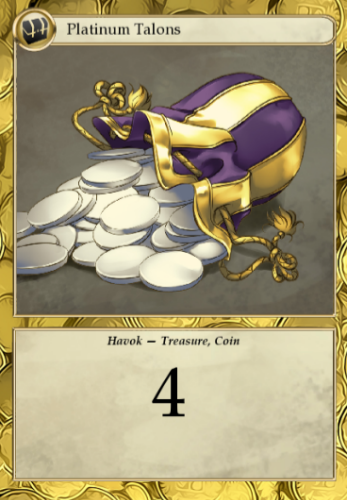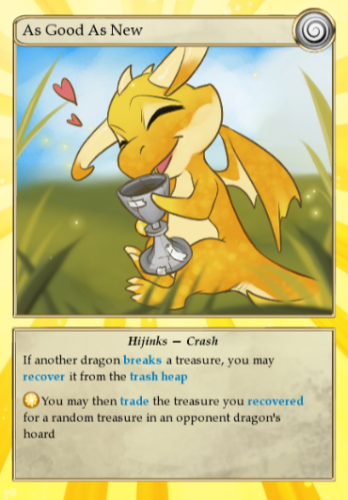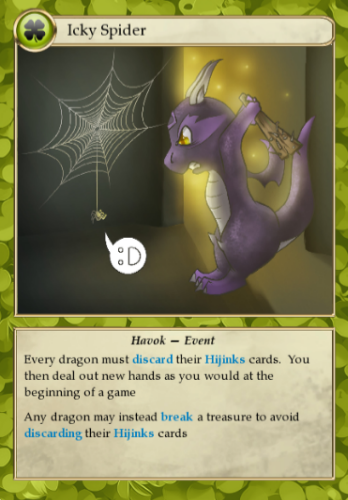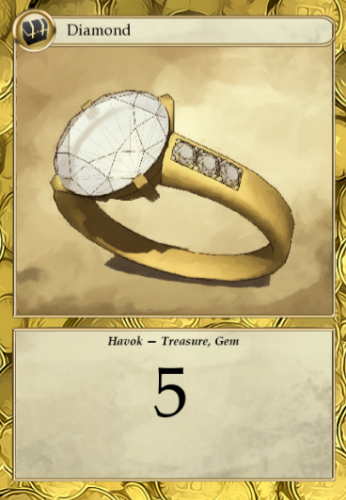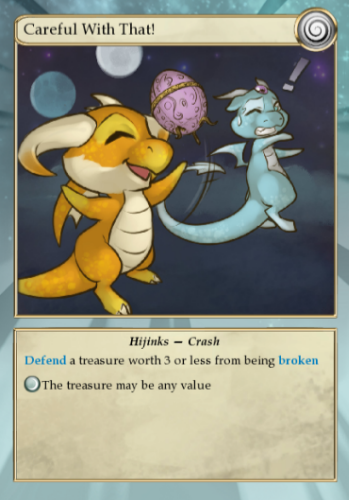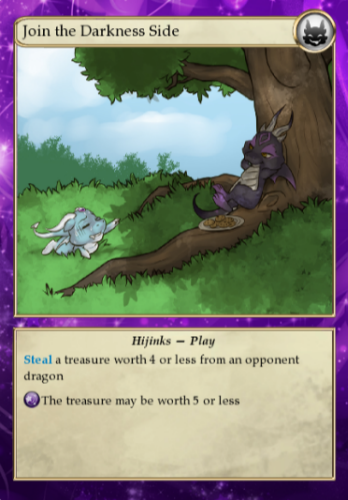When you browse through the libraries of fantasy lore, you’ll quickly find that dragons are everywhere. And why not? Dragons are sort of awesome, embodying whatever manner of imagery the author wishes to convey. They can be fearsome and bold, or reclusive and secretive. They can be mindless killing machines, or wise and mystical creatures of ages past. They are gatekeepers; they are villains. And they are not to be trifled with.
Yet dragons are rarely given an origin story. Aside from one particularly well-known story regarding three dragons, most dragon encounters come after they’ve been around the castle keep a few times. Which begs the question, how do dragons fare when they are still young and inexperienced?
Well, we’re about to find out.
The Premise
Havok & Hijinks is a light card game where players take on the roles of precocious young dragonlings seeking to make their own treasure horde. The dragons’ parents have grown tired of their offspring playing with treasure they didn’t rightfully horde themselves, and have decided it’s time they start treasure troves of their own.
The Rules
Havok & Hijinks is a light card game and is playable right out of the box. The game consists of two decks: the Havok deck and the Hijinks deck. The Havok deck represents things happening around the dragons, while the Hijinks deck involves the activities of the dragons themselves.
To begin, each player, starting with the youngest, chooses one of the four small dragons to play and is dealt three Hijinks cards. Players also receive one Bronze Talon Treasure, which is good for one VP. Treasure cards are publicly visible, both to track how much Treasure players have and to show off all the cool stuff they’ve found. The starting player is determined randomly, though feel free to choose another fitting method, such as who is holding the most loose change / shiny objects at the table.
Turns in Havok & Hijinks have two steps. First, the player reveals the top card of the Havok deck. Havok cards are either Treasures or Events. If a Treasure is revealed, it is added it to their hoard. Events, by contrast, are one-time effects that are resolved and discarded. Events range from being advantageous (such as being able to steal, trade, or destroy an opponent’s Treasure card) to unfortunate (like losing one of their own Treasures instead).
Second, the player may play one Hijinks card from their hand. Hijinks cards have two types: Play and Crash. A Play card is similar to a Havok card – it is used and discarded. Play cards accomplish a variety of tasks, though most revolve around acquiring Treasure. Alternatively, a player may discard a Hijinks card instead. If a player ever has less than three Hijinks cards, they draw back up to three.
Crash cards, on the other hand, are used in reaction to other players, dashing their mischievous antics. (For example, a Crash card could cancel an attempt at stealing a Treasure.) However, players are limited to using one card per turn. If more than one player tries to Crash the same event, players determine which one resolves by whatever random method they wish.
All Hijinks cards correspond to one of the four dragons, and each Hijinks card has an Affinity ability. If a player uses a Hijinks card matching their dragon’s type, they may use its Affinity ability in addition to the card’s effect.
Each player’s dragon also has a Play and Crash ability. These may be used in addition to playing cards, but spending them causes the dragon to flip to a “tired” state, losing those abilities until the condition is met to wake back up. Because, hey, being a baby dragon is tough work.
After the Hijinks step, it is the next player’s turn. This continues until one player has a Treasure value of 15. At that point, unless prevented via a Crash effect, that dragon wins. They get to keep their hoard and are the undisputed master of their little dragon troupe.
Everyone else is going to have some explaining to do back at the roost.
It Looks Like Fun
First off, let’s address the 800-pound dragon in the room: this game thrives on its artwork. Havok & Hijinks is about the ongoings of several small dragons competing with each other over precious treasures – or what they perceive to be treasure – and the game’s illustrations do a tremendous job bearing that out in funny and poignant ways. While the Treasure cards themselves tend to be fairly generic, the Event and Hijinks cards all have unique and entertaining visualizations of what your dragon is doing.
They also just happen to be sickeningly, stupidly, undeniably, cute.
No, really.
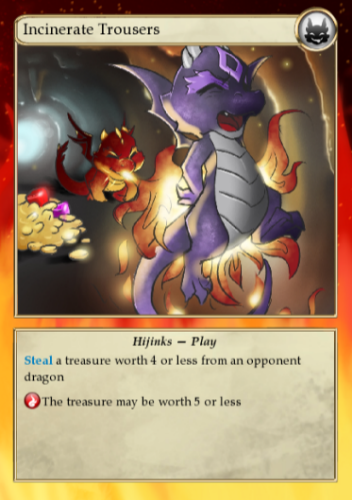 However, aside from simply being appealing to anyone who appreciates puppies and kittens and other small animals doing delightful things, the artwork in Havok & Hijinks actually has two direct influences on gameplay itself. Most notably, it gives the game some levity, preventing players from taking it too seriously.
However, aside from simply being appealing to anyone who appreciates puppies and kittens and other small animals doing delightful things, the artwork in Havok & Hijinks actually has two direct influences on gameplay itself. Most notably, it gives the game some levity, preventing players from taking it too seriously.
Indeed, Havok & Hijinks centers causing each other trouble without being too adversarial about it. Instead, the game’s combative nature is diffused through its lighthearted theme. There is still a blatant desire to win at work, but it’s hard to get upset when everyone is acting as precocious young dragons stealing shiny objects (and maybe a noble or two).
Similarly, the game’s flavor disguises the fact that Havok & Hijinks is a “screw your neighbor” game, where you intentionally antagonize other players in order to win. This game is about getting treasure though any means. Most of the time that means taking it from other players, as is evidenced by the bevy of cards that either steal Treasures from other players or prevent someone from doing so. However, because of the game’s playful nature and simple rules structure, it avoids a lot of negativity that is common in other games of this style. Moreover, playthroughs only last about 20-25 minutes, which means that you don’t run into situations where the game drags out. Havok & Hijinks ends right about when it should, and this is a game that Socializers will easily appreciate.
Immersionists should also be entertained by this game. Admittedly, the game’s world of Vallhyn is your stock fantasy setting, and unless you can use a lot of your dragon’s Affinity abilities, you never have the mindset of truly being your particular dragon. That said, the theme and mechanics have such a wonderful amount of synergy to them that you still feel like you’re in the thick of things all the same.
Diversity Of Dragons, Diversity Of Appeal
What’s less easy to discern, though, is how Strikers will respond to Havok & Hijinks. On the one hand, the game has an incredibly straightforward objective – get 15 VP worth of treasure. Plus, it does this through direct player interaction. The idea, for instance, of stealing another player’s Diamond and causing a 10 point swing in their favor is highly appealing.
On the other hand, there are occasions when a player can simply reveal a Havok card on their turn and get a Treasure card valuable enough to win. This group doesn’t like luck being the ultimate factor in determining the victor, so playthroughs where this happens will give them pause. In the end, Strikers should still enjoy Havok & Hijinks, but it won’t be a game they’ll want to do many sessions of in a row.
This is not a strategically deep game, but neither does it claim to be. With a short play time, a small hand of cards, and the outcome of your turn being at the whim of the Havok deck – and other players – this is not a game to seek if you want a lengthy cerebral engagement. (We’re looking at you Tacticians.) Even though the game has more terms than you’d expect for one so simple, it doesn’t actually increase its complexity. This also isn’t a game for those who want to explore the land and quietly build up their hoard in peace, since Treasure can be gained and lost at each step. (Now we’re looking at you Architects.) Instead, this is a game if you want cause a bit of a commotion over who gets all of the pretty pretty things.
Even for such a light game, though, there is a decent amount of diversity with the different Hijinks cards. For example, the Obsidian dragon’s cards prefer to destroy Treasures while the Pearl dragon is adept at preventing bad things from happening to you.
Yet although each dragon behaves slight differently than one another, there is still a surprising amount of parity among them. The ten dragon-affiliated Hijinks cards do differ slightly from one another, but their overall impact on the game remains largely balanced. This in turn increases the game’s replay factor, keeping you invested and giving everyone the chance to take advantage of their dragon’s abilities.
Goldilocks And The Three Dragons
Interestingly, player size turns out to be a double-edged sword for Havok & Hijinks. The entertainment value of games based around thievery and acquiring items are very beholden to the players at the table. Generally speaking, the more players there are, the more fun these games becomes. After all, if you have more targets to steal things from and more opponents to interact with, the game becomes far more dynamic. The same holds true here. Although Havok & Hijinks is designed for 2-4 players, you won’t get the same level of frivolity with two players as you will with more.
For maximum dragon capering, four players is ideal. Having a full table makes for wonderful time of dragon-based shenanigans, and Daredevils will enjoy dispensing tiny dragon justice all over the place even more. That said, four players ironically exposes what is arguably the game’s one real shortcoming, and that is card volume.
Because there are only 40 Hijinks cards (ten for each dragon), they can get cycled through pretty easily with a lot of players, and if you play more than a couple sessions in a row, you’ll start seeing the same cards over and over again. Since games of Havok & Hijinks are rather short to begin with, the result is that the game can start feeling repetitive.
The best way to alleviate cute dragon burnout is therefore to either only play it once or twice in one sitting before moving on to something else, or stretch the experience out by only having three players. Three still gives you multiple targets but doesn’t plow through Hijinks cards nearly as fast.
The Takeaway
Beneath the game’s disgustingly cute exterior, Havok & Hijinks proves to be a worthwhile game. Havok & Hijinks never pretends to be anything more than a simple card game about causing a ruccus over getting treasure. The premise is simple and moves along quickly, with every facet of the game reinforcing its theme of young dragons and their antics. What’s more, although it has fair number of card terms, the game remains very intuitive. Havok & Hijinks is the ideal sort of Filler Game: it’s short, portable, engaging, entertaining, and ends at just the right time it should.
That said, the game could benefit from some additional card variety with larger groups to maintain interest over multiple playthroughs, and the card stock could benefit from being be a tad more durable. However, Havok & Hijinks isn’t the type of game players will spent all night at the table with, instead pulling out these venturous young dragons in mixed company or if time is a factor. For those seeking a quick and simple game with a lot of heart and the most adorable dragons ever, they may wish to consider adding Havok & Hijinks to their own hoard.
Havok & Hijinks is a product of Epic Slant Press.
Cardboard Republic Snapshot Scoring (Based on scale of 5):
Artwork: 4.5
Rules Clarity: 4.5
Replay Value: 3.5
Physical Quality: 3
Overall Score: 4
Photo Credits: Havok & Hijinks cards by Epic Slant Press.

